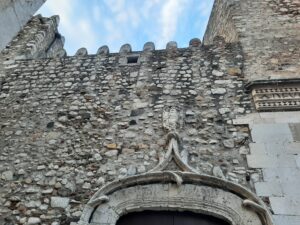In the vibrant heart of Taormina, nestled between boutiques, cafes, and ancient ruins, there’s a building that doesn’t shout to be noticed—yet quietly commands admiration: Palazzo Corvaja. Unlike other palaces that dazzle with opulence, this one intrigues with depth. It is not just a museum, nor simply a historical site. Palazzo Corvaja is a living narrative carved in stone, embodying the many layers of Sicily’s past.
 At first glance, its façade might seem austere, with its medieval windows and lava stone details. But step closer, and it begins to reveal its soul: an extraordinary blend of Arab, Norman, Gothic, and Catalan influences that reflect centuries of cultural overlap. Built initially as an Arab tower in the 10th century, later expanded by the Normans and transformed over time, the palace is a mirror of Sicily’s identity—layered, complex, and beautifully contradictory.
At first glance, its façade might seem austere, with its medieval windows and lava stone details. But step closer, and it begins to reveal its soul: an extraordinary blend of Arab, Norman, Gothic, and Catalan influences that reflect centuries of cultural overlap. Built initially as an Arab tower in the 10th century, later expanded by the Normans and transformed over time, the palace is a mirror of Sicily’s identity—layered, complex, and beautifully contradictory.
Inside, the museum offers more than exhibits—it tells stories. From ceramics and tools to historical reconstructions and artistic relics, each room invites you to step into another era. The spaces are intimate, with vaulted ceilings and timeworn stone walls that seem to echo the whispers of past inhabitants.
Perhaps the most fascinating chapter of the palace’s history is tied to the year 1411, when it hosted the Sicilian Parliament. One can easily imagine the aristocrats of the time gathering beneath the high ceilings, discussing matters of politics and power as light filtered through narrow windows. Today, this same room allows visitors to stand where history was made.
Wandering through Palazzo Corvaja, you’re not just admiring old walls—you’re walking through the soul of Taormina. The museum doesn’t simply preserve the past; it breathes life into it. The inner courtyard, with its open staircase and pointed arches, evokes the elegance of another time, while the building itself remains deeply rooted in the rhythm of the city.
Just outside, the lively streets of Taormina continue as usual. But anyone who’s stepped inside Palazzo Corvaja walks out a little changed—with a deeper understanding of the city and a greater appreciation for its rich, often hidden layers.
Visiting this museum is more than a cultural stop; it’s an immersion in the spirit of Sicily. Every stone tells a story. Every corridor carries a memory. And once you leave, part of you stays within those ancient walls—listening, feeling, remembering.
The charm of Palazzo Corvaja lies not only in its architecture or the relics it holds, but in the way it reflects Taormina’s layered identity—a crossroads where cultures met and mingled, often leaving behind more than stones and walls. Here, Sicily’s story is told not with grand statements but with enduring silence, the kind that speaks volumes.
 One of the most captivating aspects of the palace is how each architectural feature whispers its own origins. The Arab tower is solid and square, a symbol of defense and authority. The Gothic windows on the façade, delicate and ornate, show the influence of Catalan art and nobility. The Norman interventions brought structure and balance, while the Renaissance touches softened the whole with subtle elegance. It’s a place where the passage of time is etched into every corner.
One of the most captivating aspects of the palace is how each architectural feature whispers its own origins. The Arab tower is solid and square, a symbol of defense and authority. The Gothic windows on the façade, delicate and ornate, show the influence of Catalan art and nobility. The Norman interventions brought structure and balance, while the Renaissance touches softened the whole with subtle elegance. It’s a place where the passage of time is etched into every corner.
As a museum, Palazzo Corvaja invites visitors to slow down and observe—not just the artifacts, but the ambiance. You’re not in a sterile gallery space here. You’re walking through history, sometimes brushing up against it. You can almost imagine a noblewoman descending the open staircase in the courtyard, or a scribe leaning over parchment at a wooden desk in the great hall. The museum’s displays—while modest in number—are meaningful. They offer insights into daily life in medieval Sicily, showing how ordinary moments were shaped by extraordinary times.
It’s also worth noting that Palazzo Corvaja is one of the few places in Taormina where you can experience a more intimate, less commercial side of the city. While the Greek Theatre dazzles with its views and grandeur, and the Corso Umberto charms with its energy, the palace stands quietly nearby, asking only for attention—and rewarding it with something truly memorable.
If you’re planning a visit to Taormina, don’t overlook Palazzo Corvaja. Take your time. Arrive early or in the calm of late afternoon, when the light softens and the crowds thin. Let your eyes adjust to the shadowed corridors and warm stone walls. Let your imagination roam.
Because this isn’t just a palace. It’s a place where the soul of Sicily lingers—in the stones, the silence, and the centuries that shaped them.

